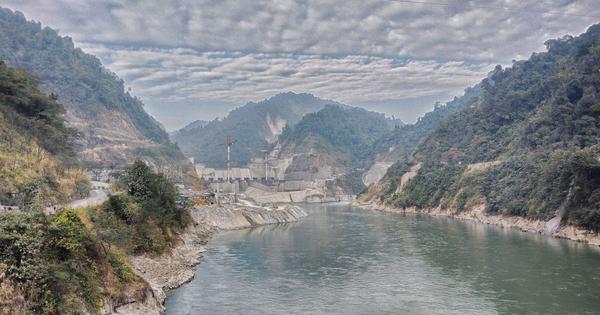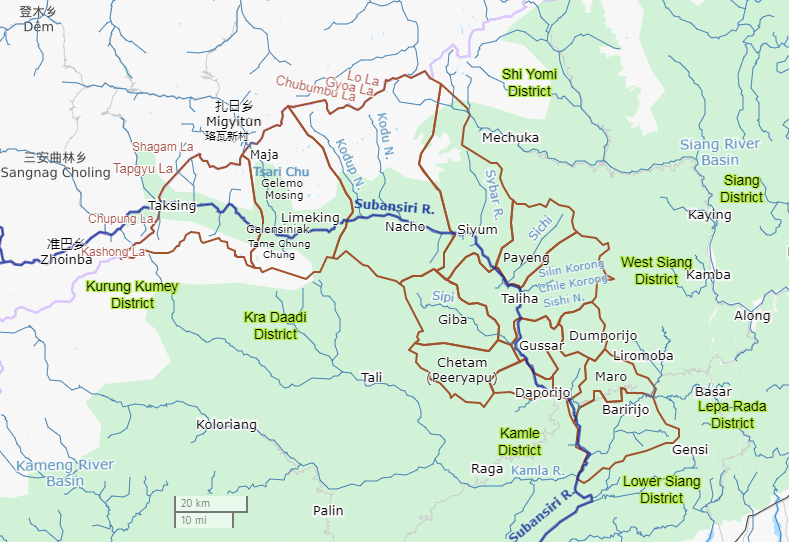
A 2,200 megawatt hydropower project was cleared to come up in the Upper Subansiri district of Arunachal Pradesh, signalling the state government’s intent to rapidly expand hydropower generation within its borders. The Oju Hydroelectric Power Project is the latest of several large dams proposed to boost the state government’s hydropower profile.
The Oju Hydroelectric Power Project was cleared by the centrally-appointed Expert Appraisal Committee on September 12, on the condition that the Navayuga Engineering group – the project developer – integrate simulations of glacial lake outburst flood scenarios into its design.
“The Committee advised that a real-time monitoring and early warning system (EWS) shall be established in coordination with State Disaster Management Authority (SDMA) and local administration, along with community awareness and mock drills for preparedness,” the Expert Appraisal Committee said, in light of growing glacial lakes in the region.
The Oju Hydroelectric Power Project is the second major dam to secure clearance in the Subansiri river basin. The Subansiri Lower Dam, a 2000 MW run-of-the-river project (harnessing the natural flow of a river) further downstream, was awarded clearance in 2003, but faced widespread opposition from local communities and activists about the negative impacts from 2010 to 2019.
“When the Subansiri Lower Dam was being cleared, one of the conditions was that there would be no further construction upstream.” said Himanshu Thakkar, coordinator of South Asia Network on Dams, Rivers and People. “This was appealed and now projects such as Oju have been allowed on a case-to-case basis.”
The environmental impact assessment for the Oju Hydroelectric Power Project says that there are no protected areas or biodiversity reserves at the site of the power project. However, the Upper Subansiri district is almost entirely covered by forests including alpine scrub, moist evergreen, and temperate forests.
The full, cumulative impact of multiple dams on the river system is also uncertain. The Subansiri basin falls in Seismic Zone V, the most vulnerable category, and the data used for the river’s carrying capacity was last published in 2014 – over a decade ago.
Decade of hydropower
Clearance for the Oju Hydroelectric Power Project comes amid a big push from the state government to generate more hydroelectricity and “secure” border areas close to China. The Arunachal Pradesh state cabinet announced 2025 to 2035 to be the “Decade of Hydropower”.
The state plans to commission 13 large hydropower projects over the next three years and generate 19,000 MW of hydropower by the end of the decade. “This is a decade-long mission to fast track all green energy projects,” Chief Minister Pema Khandu said at a press event in August. “Green energy will be our strength, export, and identity.”
“The speed with which projects are being cleared in Arunachal Pradesh raises concerns about the quality of impact assessments. We’ve seen with the Subansiri Lower Project that mistakes about downstream impacts were made that needed to be corrected,” said Sumit Vij, assistant professor at Wageningen University in the Netherlands.
A critical assessment of the environmental impact assessment for the Lower Subansiri Dam found that it only surveyed downstream impacts up to seven kilometres from the dam site and failed to record important endangered species like the Ganges river dolphin, which is commonly found in the river.
Indigenous communities involved in clearance processes have raised similar concerns for dams planned across the state. In the case of the 2,880 MW Dibang Multipurpose Project, located in the eastern frontier of the state, communities objected to the loss of their traditional lands that served as grazing grounds for mithun and on which they cultivated medicinal plants.

More than 200 people attended the public hearing for the Oju Hydroelectric Power Project . Minutes of the meeting attached to the impact assessment report reveal the concerns of families present.
For example, Keru Chader, a member of the Nah tribe, raised concerns about losing grazing land and likened it to “a holy place just like Amarnath.” In response, the administration simply said, “no impact on holy places in the project area and its surroundings are envisaged”.
Water and Power Consultancy Services India Ltd, a central public sector enterprise and engineering consultancy, carried out the environmental impact assessments for the Lower Subansiri Infrastructure Project and the Oju Hydroelectric Power Project.
It also conducted the impact assessment for the upcoming 1,200 MW Kalai II Hydropower project on the Lohit river. A legal notice issued to the consultancy on September 9, reviewed by Mongabay India, alleges the impact assessment for the Kalai II project was prepared “without conducting any fresh scientific studies, site-specific assessments, or updates to reflect current environmental, social, and ecological conditions.”
The Water and Power Consultancy Services India Ltd is accredited by the National Accreditation Board for Education and Training to carry out environmental impact assessments.
The central government is playing an active role in supporting Arunachal Pradesh’s hydropower ambitions. In 2023, the central government signed a Memorandum of Understanding with the state to take over 12 dams whose progress had been stalled – including the 3,097 MW Etalin project. Central Public Sector Undertakings, and not private players, would take over operations to improve their efficiency, the government said.
This article was first published on Mongabay.
📰 Crime Today News is proudly sponsored by DRYFRUIT & CO – A Brand by eFabby Global LLC
Design & Developed by Yes Mom Hosting






